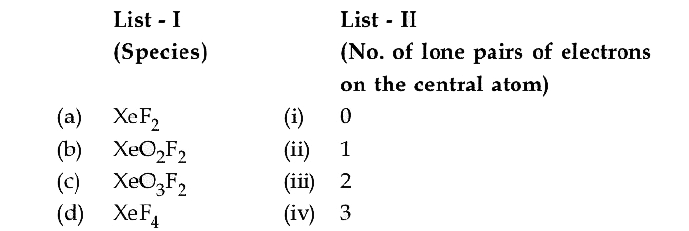The two methods of conversion of concentrated ore to oxide are
I. Calcination
II. leaching
III.roasting
IV.levigation. Choose the most appropriate option from the choices given below.
I and III
II and III
I and IV
II and IV
The correct Answer is:A
To answer the question about the two methods of conversion of concentrated ore to oxide, we need to analyze the given options:
1. Calcination
2. Leaching
3. Roasting
4. Levigation
Step 1: Understanding Calcination
Calcination is a thermal treatment process that typically occurs in the absence of air or with a limited supply of air. It is primarily used to convert metal carbonates into oxides. For example, when zinc carbonate (ZnCO₃) is heated, it decomposes into zinc oxide (ZnO) and carbon dioxide (CO₂).
Step 2: Understanding Roasting
Roasting is another thermal process but occurs in the presence of excess air. It is used to convert metal sulfides into oxides. For instance, when zinc sulfide (ZnS) is roasted, it is converted into zinc oxide (ZnO) and sulfur dioxide (SO₂).
Step 3: Evaluating Leaching
Leaching is a hydrometallurgical process that involves the extraction of metals from their ores using solvents. While it is an effective method for extracting metals, it does not directly convert ores to oxides.
Step 4: Evaluating Levigation
Levigation is a mechanical process used to separate impurities from ores based on differences in density. It does not involve the conversion of ores to oxides.
Conclusion
From the analysis above, the two methods of conversion of concentrated ore to oxide are:
- I. Calcination
- III. Roasting
Thus, the most appropriate option is I and III.
2. Leaching
3. Roasting
4. Levigation
Calcination is a thermal treatment process that typically occurs in the absence of air or with a limited supply of air. It is primarily used to convert metal carbonates into oxides. For example, when zinc carbonate (ZnCO₃) is heated, it decomposes into zinc oxide (ZnO) and carbon dioxide (CO₂).
Roasting is another thermal process but occurs in the presence of excess air. It is used to convert metal sulfides into oxides. For instance, when zinc sulfide (ZnS) is roasted, it is converted into zinc oxide (ZnO) and sulfur dioxide (SO₂).
Leaching is a hydrometallurgical process that involves the extraction of metals from their ores using solvents. While it is an effective method for extracting metals, it does not directly convert ores to oxides.
Levigation is a mechanical process used to separate impurities from ores based on differences in density. It does not involve the conversion of ores to oxides.
From the analysis above, the two methods of conversion of concentrated ore to oxide are:
- III. Roasting
Similar Questions
Knowledge Check
- Question 1 - Select One
Match List - I with List- II

Choose the most appropriate answer from the options given below -A(a)→(ii),(b)→(iii),(c)→(iv),(d)→(i)B(a)→(i),(b)→(iv),(c)→(iii),(d)→(ii)C(a)→(i),(b)→(iii),(c)→(iv),(d)→(ii)D(a)→(iv),(b)→(i),(c)→(ii),(d)→(iii) - Question 2 - Select One
Match List - I with List- II

Choose the most appropriate answer from the options given below -A(a)→(i),(b)→(iii),(c)→(iv),(d)→(ii)B(a)→(ii),(b)→(i),(c)→(iv),(d)→(iii)C(a)→(ii),(b)→(iv),(c)→(i),(d)→(iii)D(a)→(iii),(b)→(i),(c)→(ii),(d)→(iv)
Match List - I with List - II.

Choose the most appropriate answer from the options given below :View SolutionMatch List I with List II :

Choose the most appropriate answer from the options given belowView SolutionMatch List - I with List -II

Choose the most appropriate answer from the options given below :View SolutionMatch List-I with List -II

Choose the most appropriate answer from the options given below:View SolutionMatch List-I with List-II :

Choose the most appropriate answer from the options given below :View SolutionMatch List-I with List-II :

Choose the most appropriate answer from the options given below :View Solution


